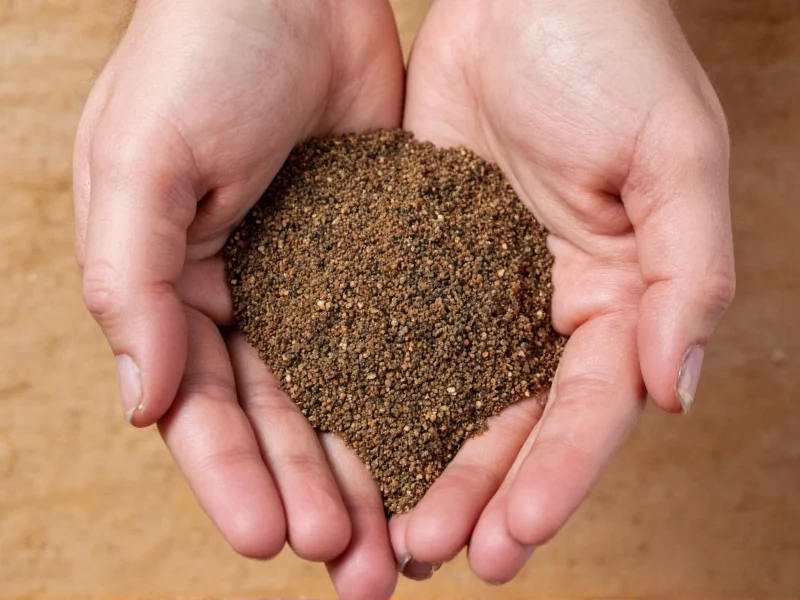Understanding how ground pepper is made reveals a surprisingly straightforward process rooted in centuries of culinary tradition. Unlike many processed foods, ground pepper production involves no chemical alterations or artificial additives—just the physical transformation of dried peppercorns. This natural approach preserves pepper's distinctive flavor compounds, particularly piperine, which gives pepper its characteristic heat and aroma.
The Journey from Peppercorn to Powder
Peppercorns themselves are the dried fruit of the Piper nigrum vine, native to South India but now cultivated in tropical regions worldwide. Before grinding can occur, these berries undergo careful harvesting and drying processes:
- Black peppercorns are picked when nearly ripe and sun-dried, causing them to shrivel and darken
- White peppercorns come from fully ripe berries soaked to remove the outer layer before drying
- Green peppercorns are harvested while unripe and preserved through freeze-drying or brining
Traditional Grinding Methods
For centuries, cultures around the world developed manual techniques for how is black pepper ground in home and commercial settings. Early methods included:
- Mortar and pestle crushing—still preferred by many chefs for small batches
- Stone grinding wheels turned by hand or animal power
- Wooden pepper mills with ceramic or metal grinding mechanisms
These traditional pepper milling process explained techniques relied on physical pressure and abrasion to break down the peppercorns while preserving their essential oils and flavor compounds.
Modern Commercial Production Process
Today's industrial commercial ground pepper production follows these key steps:
- Sorting—Peppercorns pass through optical scanners and sieves to remove impurities
- Cleaning—Removal of dust, stems, and foreign materials
- Grinding—Passage through industrial mills with adjustable settings for fine or coarse grind
- Sieving—Screening to ensure consistent particle size
- Packaging—Immediate sealing in airtight containers to preserve freshness
Contrary to common misconceptions, reputable manufacturers don't add anti-caking agents or preservatives to pure ground pepper. The process of making ground pepper remains remarkably simple and natural.
| Grinding Method | Grind Size | Flavor Preservation | Best For |
|---|---|---|---|
| Manual Pepper Mill | Adjustable (fine to coarse) | Excellent (freshly ground) | Daily cooking, table use |
| Electric Grinder | Consistent medium | Good | Batch preparation |
| Industrial Mill | Precise (customizable) | Very Good | Commercial production |
| Mortar and Pestle | Variable (depends on technique) | Exceptional | Specialty dishes, small batches |
Why Freshly Ground Pepper Outperforms Pre-Ground
The difference between freshly ground pepper and store-bought pre-ground extends beyond mere preference. When you learn how to make ground pepper at home, you unlock significant advantages:
- Superior flavor—Whole peppercorns retain essential oils that evaporate quickly after grinding
- Stronger aroma—Volatile compounds dissipate within minutes of grinding
- Brighter heat—Piperine remains more potent in freshly ground form
- No adulteration risk—Commercial pre-ground pepper sometimes contains fillers
Food scientists have documented that ground pepper loses up to 50% of its volatile aroma compounds within 15 minutes of grinding when exposed to air. This explains why freshly ground pepper vs pre-ground makes such a dramatic difference in culinary applications.
Avoiding Adulterated Pepper Products
While pure ground pepper contains only peppercorns, some manufacturers cut costs by adding:
- Rice flour or other starches
- Ground papaya seeds (mimics pepper appearance)
- Other cheaper spices
To ensure you're getting authentic product, look for single-ingredient labeling and purchase from reputable sources. The peppercorn to ground pepper process should never involve additives when producing pure pepper.
Proper Storage for Maximum Freshness
Once ground, pepper begins losing its potency. To extend shelf life:
- Store in airtight containers away from light and heat
- Keep whole peppercorns rather than pre-ground whenever possible
- Buy in small quantities that you'll use within 3-4 months
- Never store near stovetops or in clear containers on spice racks
For home cooks interested in the complete traditional pepper grinding methods, investing in a quality pepper mill with ceramic or stainless steel grinding mechanism provides the best balance of convenience and flavor preservation.
Does ground pepper contain any additives or chemicals?
Pure ground pepper contains only peppercorns with no additives or chemicals. The grinding process is purely mechanical. Some lower-quality commercial products may contain anti-caking agents or fillers, so checking the ingredient list for "100% pepper" is recommended for pure product.
How long does freshly ground pepper stay fresh?
Freshly ground pepper begins losing its volatile flavor compounds immediately. It retains optimal flavor for about 15-30 minutes after grinding, with significant degradation occurring within hours. For best results, grind pepper immediately before use rather than storing pre-ground pepper for extended periods.
What's the difference between black and white ground pepper production?
Black pepper is made from nearly ripe peppercorns that are sun-dried, while white pepper comes from fully ripe berries that have had their outer layer removed through soaking before drying. This difference in processing gives white pepper a more earthy, less complex flavor profile compared to the sharper, more floral notes of black pepper.
Can I make ground pepper at home without special equipment?
Yes, you can make ground pepper at home using basic kitchen tools. A mortar and pestle provides excellent results for small quantities. Alternatively, a clean coffee grinder dedicated to spices, a rolling pin with a plastic bag, or even crushing peppercorns between two heavy plates can work in a pinch. The key is starting with whole, high-quality peppercorns.
Why does freshly ground pepper taste different from pre-ground?
Freshly ground pepper contains higher concentrations of volatile aromatic compounds and piperine (the compound responsible for pepper's heat). These compounds begin evaporating immediately after grinding. Pre-ground pepper loses up to 50% of its volatile compounds within 15 minutes, resulting in noticeably less complex flavor and reduced pungency compared to freshly ground pepper.











 浙公网安备
33010002000092号
浙公网安备
33010002000092号 浙B2-20120091-4
浙B2-20120091-4